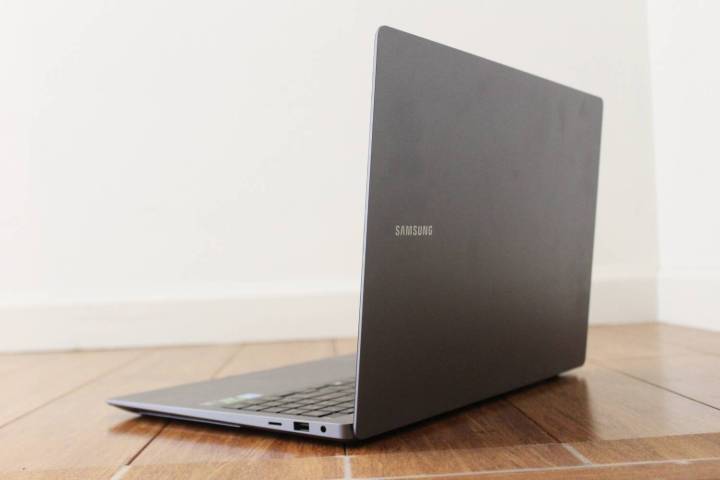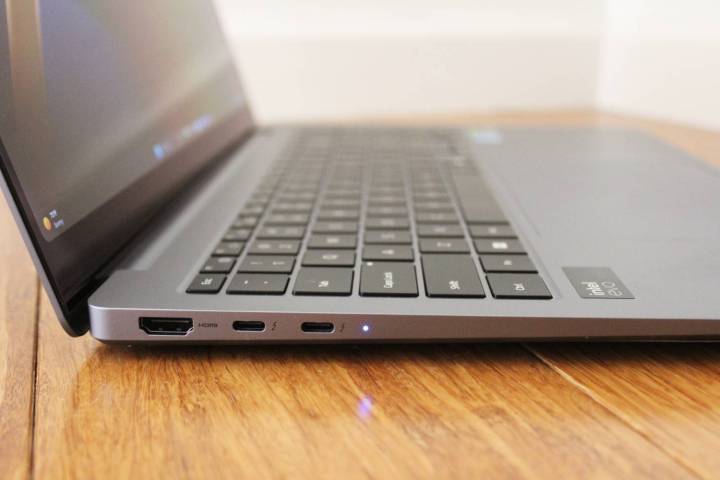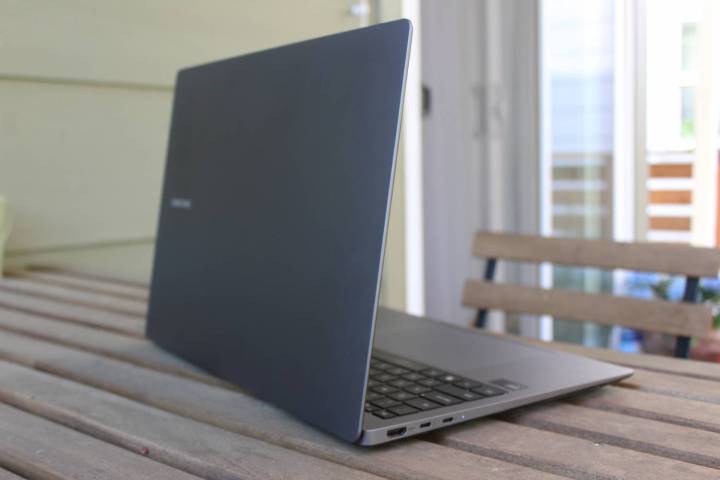
Samsung Galaxy Book4 Ultra
MSRP $3,000.00
“The Samsung Galaxy Book4 Ultra is ambitious, but ultimately falls short of the competition.”
Pros
- Surprisingly portable
- Beautiful OLED screen
- Good battery life
- Cheaper than the MacBook Pro
- Quiet and cool
Cons
- Underpowered without performance mode
- No SD card slot
- Lackluster keyboard
- Poor webcam and speakers
What does it take to beat the MacBook Pro these days? More than you might assume. After all, I’m not talking about the measly 14-inch M3 model. With its new Galaxy Book4 Ultra, Samsung has its eye on the big boy – the M3 Max 16-inch MacBook Pro.
Very few non-gaming laptops have sought to challenge the M3 Max MacBook Pro on the graphics front, but the Galaxy Book4 Ultra, with up to an RTX 4070 and a Core Ultra 9 185H processor, is one of them. At least, on paper.
Unfortunately, it missteps in a couple of important ways that keep it out of reach of its competitors.
Specs and pricing
| Samsung Galaxy Book4 Ultra (2024) | |
| Dimensions | 13.99 x 9.86 x 0.65 inches |
| Weight | 4.1 pounds |
| Processor | Intel Core Ultra 7 155H Intel Core Ultra 9 185H |
| Graphics | Nvidia RTX 4050 Nvidia RTX 4070 |
| RAM | 16GB 32GB |
| Display | 16-inch, 2880 x 1800 120Hz AMOLED |
| Storage | 1TB PCIe 4.0 NVMe SSD |
| Touch | Yes |
| Ports | 1x HDMI 2.1a, 2x Thunderbolt 4, 1x USB-A 3.2, 1x MicroSD |
| Wireless | Wi-Fi 6E, Bluetooth 5.3 |
| Webcam | 1080p with Windows Hello |
| Operating system | Windows 11 Home |
| Battery | 76 watt-hours |
| Price | $2,400 $3,000 |
| Where to buy |
The Galaxy Book4 Ultra comes in just two preconfigured models. The cheaper model costs $2,400 and includes a Core Ultra 7 155H, RTX 4050, 16GB of RAM, and 1TB of storage. The more expensive model, which I am reviewing, included a Core Ultra 9 185H, RTX 4070, 32GB of RAM, and a 1TB SSD. It costs $3,000, which is quite a lot for this set of specs.
You can get plenty of gaming laptops with similar performance for much less. For example, the ROG Zephyrus G16 sells for $1,750, and it comes with an RTX 4070, 16GB of RAM, and 1TB of storage. And sure, that’s less RAM than my review unit of the Galaxy Book4 Ultra, but it’s well over $1,000 less – and it even comes with an OLED screen. Or there’s the Alienware m16 R2, which can be configured to match the Galaxy Book4 Ultra (outside of the OLED screen) for $750 less.
It’s considerably cheaper than the Dell XPS 16, however, which might be its most direct competitor. When those two are similarly configured, it’s $550 cheaper.
The Lenovo Yoga Pro 9i 16 is the laptop that creates the biggest pricing problem for the Galaxy Book4 Ultra. It sells for just $1,900, coming with the same processor, RAM, and storage, and an RTX 4060. Despite having a supposedly “weaker” GPU, though, performance is surprisingly equal (more on that later).
Design

The Galaxy Book4 Ultra isn’t particularly flashy. It’s a basic silver laptop without a lot of pizzazz. If it weren’t for the Samsung logo on the lid, you’d be hard-pressed to distinguish this from any other. You might claim Samsung is striving for a simple, MacBook-like design, but it comes across as a bit dull.
It does have a couple of noteworthy elements, however. One of the design flourishes I do like is the rounded corners of the screen. This fits well with the vibe of Windows 11, matching the rest of the Galaxy Book4 lineup and the MacBook Pro. It also has a fairly thin bezels across the top of the screen. But aside from that, this is as plain-looking a laptop as you’ll find.
The size of the laptop is an important aspect of the design too. It weighs 4 pounds and is just 0.65 inches thick, which is very thin for a laptop with this much power. It’s quite a bit thinner than the Dell XPS 16 and is even marginally thinner than the 16-inch MacBook Pro. You won’t find a more portable laptop that can also be configured with an RTX 4070. That’s an accomplishment all on its own.
The Galaxy Book4 Ultra also feels well-built. Samsung calls it a “sturdy, yet lightweight metal frame,” which sounds a bit right. It’s not a single chunk of machined aluminum, but there aren’t any noticeable spots of flex or weaknesses in rigidity.
Display

The Galaxy Book4 Ultra display features a 2880 x 1800 resolution with a 16-inch screen size, for a pixel density of 212 ppi (pixels per inch). That’s not quite as pixel-dense as the 16-inch MacBook Pro or Dell XPS 16, but you won’t probably complain about the sharpness of the screen. It also has a 120Hz variable refresh rate, matching the MacBook Pro. That’s all good stuff.
But remember — this is an OLED panel, similar to the Dell XPS 16. This means that not only do you get incredible contrast, but fantastic colors as well. It has wide color contrast, hitting 96% AdobeRGB and 100% DCI-P3, as well as fantastic color accuracy with a Delta-E of 0.74. All of that is supremely important for a laptop made for creators.
Samsung has also included an anti-reflective coating, resolving a problem with a lot of older OLED laptop screens. You’re not constantly staring at your own reflection — and even glare isn’t too distracting. A max of 376 nits of brightness isn’t overly bright, of course, but it’s typical for OLED. Both IPS and mini-LED screens can get brighter, with the MacBook Pro being the brightest laptop screen with the most impressive HDR effect. The Lenovo Yoga Pro 9i 16 gets close, however, hitting 652 nits of SDR brightness and up to 1,000 of peak HDR brightness.
The MacBook Pro has the overall better screen, but the Galaxy Book4 Ultra’s display is still impressive.
Ports

The Galaxy Book4 Ultra has a solid selection of ports. There are two USB-C ports, a USB-A port, HDMI 2.1, and a headphone jack. That’ll give you everything you need without having to resort to dongles.
There’s one exception, though. It’s missing an SD card slot, which is something the XPS 16 lacks as well. There clearly isn’t enough room on the side given the shape of the edge, which is based on the placement of the vents and speakers. Still, it’s a detriment to those who frequently need to transfer files directly from a camera.
It does include a microSD card slot, however, which could be useful for storage expansion or uploading from a drone.
Keyboard and touchpad
The keyboard is one of my biggest hang-ups with the Galaxy Book4 Ultra. The key travel feels very short, reminding me a bit of the old butterfly mechanism MacBooks. It’s just not a very comfortable typing experience. I wouldn’t call it a deal killer, but it takes a while to get used to.
Also important to note is the addition of the number pad on the right. Samsung continues to be determined to include the extra keys, despite the fact that most laptop manufacturers have moved on from including them – even on laptops of this size. I contend that the number pad has a fairly niche use case these days, and that the downside of having to position the trackpad off-center just isn’t worth it.

Speaking of the trackpad, the Galaxy Book4 Ultra uses a decent one. It’s quite large and does a good enough job, with smooth tracking and palm rejection. The click is a bit stiff and loud for my taste, though. I’ve really enjoyed the move to haptic feedback trackpads.
On the security front, the Galaxy Book4 Ultra includes both a fingerprint reader integrated into the power button and an IR camera built into the top bezel next to the webcam for Windows Hello.
Webcam and speakers
The Galaxy Book4 Ultra comes with a 1080p webcam and a quad-speaker setup. Unfortunately, both are fairly disappointing. The video quality is very grainy and full of artifacts — and that’s even in relatively decent lighting. It can get by for the occasional video call, but this isn’t the kind of laptop I’d recommend for someone who spends all day on camera.
The speakers aren’t much better. Despite the large chassis, the Galaxy Book4 Ultra’s speakers sound pretty tinny and lacking in bass. You’ve got two upward-facing speakers and two along the sides, but the sound profile is pretty subpar.
Next to even a 13-inch MacBook Air (never mind the 16-inch MacBook Pro), the Galaxy Book4 Ultra sounds pitiful.
Performance
As mentioned earlier, the Galaxy Book4 Ultra has very limited configurations. That being said, I like how Samsung has specced these out. It removes some of the technical decisions put on buyers needing to choose between a Core Ultra 7 and Core Ultra 9. It also helps people avoid mistakes such as buying too little or too much memory. The $600 price difference feels fair too.
But it’s the RTX 4070 and Core Ultra 9 185H that I’m most interested in. After all, there have been plenty of similar Samsung laptops in the past without this much GPU horsepower. That’s the bit that makes this laptop special – at least, in theory.
There’s a couple of important broad statements to make before getting into the details. First of all, the RTX 4070 in the Galaxy Book4 Ultra isn’t as powerful as it is in gaming laptops like the HP Omen 16 or Alienware m16 R2 or thicker creator laptops like the Asus ProArt Studiobook Pro. It can only deliver 80 watts of power to the GPU, meaning this RTX 4070 won’t always outperform a lower-class GPU. A great example is the RTX 4060 in the Lenovo Yoga Pro 9i 16. Despite using a similar-sized chassis, the Yoga Pro 9i’s graphics performance is often just as good as that of the Galaxy Book4 Ultra — and sometimes even better.
That’s especially true when testing in the Galaxy Book4 Ultra’s default Optimized mode. The laptop can regain a lot of that difference (around 15%) when you bump it back to the High Performance mode found in the Samsung Settings app, which makes it much more competitive. Most performance modes in laptops only make around 5% of difference, but Samsung has clearly held back the performance considerably in the default Optimized mode. The result is a quieter, cooler laptop, but one that is hamstrung in GPU performance in particular if you don’t change that setting.
The other important point to make is that the Galaxy Book4 Ultra is still behind the M3 Max MacBook Pro, even while using the Samsung’s High Performance mode. It doesn’t really matter what benchmark you compare, the M3 Max MacBook Pro is faster. Take Cinebench R24, for example, where the M3 Max is 23% faster in single-core, 46% faster in multi-core, and 38% faster in GPU.
Again, toggle on the Galaxy Book4 Ultra’s High Performance, and both the multi-core and GPU scores increase by 15%. That makes the comparison closer, but the M3 Max takes the cake regardless. I wish I had data on the M3 Pro configuration to see how it compares, as that’ll likely end up being a closer competitor.
With those two notes out of the way, it’s interesting to take a look at how the Galaxy Book4 Ultra compares to a closer competitor like the Dell XPS 16. The two machines are relatively similar in size and thickness, and both models we tested came with a Core Ultra 9 185H and RTX 4070. It’s a perfect comparison.
| Geekbench 6 (single/multi) | Cinebench R24 (single/multi/GPU) | Pugetbench Premiere Pro | 3DMark Time Spy | |
| Samsung Galaxy Book4 Ultra (Core Ultra 185H / RTX 4070) | 2373 / 13082 Perf: 2331 / 13381 | 107 / 817 / 8,994 Perf: 106 / 985 / 10569 | 3906 Perf: 5669 | 7242 Perf: 10207 |
| Lenovo Yoga Pro 9i 16 (Core Ultra 185H / RTX 4060) | 2373 / 13082 Perf: 2,331 / 13381 | 110 / 1085 / 9859 Perf: 112 / 1115 | 5774 Perf: 6112 | 10733 Perf: 12832 |
| Dell XPS 16 (Core Ultra 7 155H / RTX 4070) | 2196 / 12973 Perf: 2238 / 12836 | 100 / 838 / 9721 Perf: 102 / 895 / 10,477 | 5401 Perf: 5433 | 8216 Perf: 9352 |
| Asus ROG Zephyrus G16 (Core Ultra 9 185H / RTX 4070) | N/A | 109 / 964 / 10979 Perf: 110 / 1,069 / 11475 | 5073 Perf: 5115 | 10828 Perf: 12159 |
| Alienware m16 R2 (Core Ultra 7 155H / RTX 4070) | 2366 / 12707 Perf: N/A | 103 / 1,040 / 10884 Perf: N/A | 5590 Perf: N/A | 5590 Perf: N/A |
| Apple MacBook Pro 16 (M3 Max 16/40) | 3083 / 20653 Perf: 3119 / 20865 | 140 / 1667 / 13146 Perf: N/A | 8046 Perf: N/A | N/A |
In general, the Galaxy Book4 Ultra’s performance is behind the XPS 16 in the default mode, but has a larger upper range on the top end. That’s true across synthetic benchmarks and also in games. In both Red Dead Redemption 2 and Cyberpunk 2077, the Galaxy Book4 Ultra can get decent frame rates, though you’ll want to stick to 1200p resolution and use frame generation. But again, only with the High Performance turned on will you get frame rates remotely satisfying for this GPU.
For example, in Cyberpunk 2077 in 1200p resolution at the Ultra preset (which turns FSR 2.1 on to Auto), the frame rate jumps from just 49 frames per second (fps) up to 79 fps. Compare that when testing those same settings on the XPS 16, which starts at an average of 68 fps in its Balanced mode and can hit 78 fps in its Performance mode.
Whether or not that’s a smart move or makes for an overall better laptop is debatable. I have a feeling not many people will bother going to hunt for the Samsung Settings app to find the High Performance toggle — and therefore they will never experience the full performance you can get out of this laptop. When you’re trying to play a game or render a video timeline, that’s a shame, especially given how tuned down the fans are in the Optimized setting.
On the other hand, if you use it smartly, the Galaxy Book4 Ultra can giveyou the best of both worlds: Quiet performance for web browsing and general work or all fans ablaze when you need it to speed up intense workflows. That’s kind of ideal if you know how to make it work for you.
Battery life
The Galaxy Book4 Ultra has just a 76 watt-hour battery, and yet, it has surprisingly good battery life. It lasted 11 hours and 45 minutes in our web-browsing battery test, which cycles through a series of heavy websites until the battery dies.
While this is still significantly behind the 16-inch MacBook Pro, the Galaxy Book4 Ultra still has the best battery life of any Windows laptop of this type. And by that, I mean a laptop that has a discrete GPU. Samsung’s underperforming Optimized mode could be why the Galaxy Book4 Ultra lasts so long, but either way, I’m impressed. It’s the one clear advantage it has over the XPS 16 and Lenovo Yoga Pro 9i 16, which both last nearly half as long.
Should you buy the Galaxy Book4 Ultra?

I’m really glad the Galaxy Book4 Ultra exists. We need more proper MacBook Pro alternatives that can compete on a higher level. Now, the Galaxy Book4 Ultra can’t rival the M3 Max in performance verbatim, but it undercuts it in price. It’s still an expensive laptop, of course, but it still comes in hundreds of dollars cheaper than the 16-inch MacBook Pro.
It’s also cheaper than the XPS 16. And while it’s not as premium-looking as the XPS, the Galaxy Book4 Ultra offers a more conventional design at a lower price. It also squeezes in more high-end features than something like the cheaper MSI Prestige 16. The Galaxy Book4 Ultra finds a solid hole to fill in the market. In a lot of ways, it makes more sense than some of the other Galaxy Book4 laptops in the lineup, which are often overpriced.
The existence of the Yoga Pro 9i is the main problem with the Galaxy Book4 Ultra. It’s just not worth that extra $1,000, especially since Lenovo has the better keyboard and port selection. Unless extra battery life is a high priority for you, the Galaxy Book4 Ultra is tough to recommend against some of its competitors.
Editors’ Recommendations
->Google Actualités









